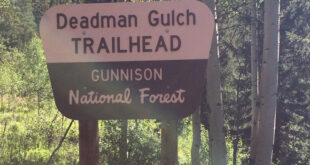“Seriously looking at program deterioration in the district"
Looking ahead to how the area’s public schools will be funded next year, Gunnison Watershed district business manager Stephanie Juneau gave the board of education a rather grim view of future funding in the preliminary budget for 2013 and 2014.
Juneau told the board there was some good news and some bad news in the proposal, which shows some signs of growth in the student population alongside some lost revenue and rising costs. To bridge a potential budgetary gap, Juneau recommended dipping into a healthy reserve fund for next year.
But without a long-term solution to the funding shortfall, she suggested the district might be heading for a ballot question about a mill levy override to avoid making serious cuts.
“We’ll start with the good news,” Juneau said. First, the district is anticipating the student population will grow next year by about 15 students, to 1,743. The district is also expecting almost $238 more in state funding per student next year. “The district’s per pupil revenue, which is comprised of local and state sources, is expected to increase next year and generate an additional $514,000.”
The cushion, however, is quickly compressed by a loss in federal funds that, for the last four years, have been padding the school district’s coffers. Losing that money, which is paid to the county and split with the school district for local federal lands that don’t pay property tax, will cost the district $448,000.
Out of the $14.6 million in revenues the school district budgets for, next year’s total is going to come in about $186,000 short.
At the same time salaries and workers compensation insurance and the district’s contribution to teachers’ retirement are all expected to cost more next year. Two of the district’s cars are in desperate need of replacement, Juneau said; the district’s contribution to the Public Employee’s Retirement Account (PERA) keeps going up; and the transportation costs are up $69,000 partly because the district has to pay bus drivers from Gunnison to drive the Crested Butte routes after no locals could be found to help. Even the infamous “sequestration” is going to cost the district about $60,000, Juneau said.
The list of expenses, combined with a decrease in revenues, pushed the preliminary budget about $486,000 into the red, which led the Administrative Council (AdCo) to recommend the board approve a withdrawal of $500,000 from the district’s $2.7 million general fund reserves.
“We’ve been able to build up that fund balance because of four years of [federal] funding. We feel very fortunate about that,” Juneau said. “Without that funding and without using the fund balance, we would have to seriously look at programs and positions within the district.”
The district’s increasing costs aren’t confined to the administrative, as the maintenance and transportation departments are also asking for more money to keep the newly renovated school buildings in top shape and keep the district’s fleet of buses in working order.
“There’s still the $1.2 million in capital reserve. We are proposing starting to use that in the next fiscal year,” Juneau said. “Using a five year plan … an additional approximately $150,000 for facilities and vehicle purchases would be necessary for each of the next four years.”
Even drawing on the fund balances, the district is faced with reducing one half-time elementary teaching position at Crested Butte Community School and two elementary teaching positions in Gunnison, not through the elimination of teachers but by rearranging schedules.
The reduction in teachers doesn’t mean, however, that the district will exceed its own teacher to student ratio of 16 to 19 kids per kindergarten class, 19 to 23 in first through third grade classes, and 20 to 25 kids in fourth and fifth grade classes.
And there’s still some serious financial belt-tightening to come if a long-term solution isn’t found soon.
Juneau said one such solution would be for voters to approve a November ballot measure being proposed by Sen. Mike Johnston and sponsored by Rep. Millie Hamner, known as the Future School Finance Act. The proposal would adjust the formula being used to determine state and local sources of funding. “That may bring in additional revenue of $1.2 million to our school district, if it were to pass in the November 2013 election,” Juneau said.
“If the Johnston Bill were not to pass this coming fall, then AdCo would strongly recommend the board be considering a mill levy operating override for our school district,” Juneau said. “If that were not pursued and the Johnston Bill didn’t pass then we would have to be seriously looking at program deterioration in the district. Fewer jobs, cutting some major programs, etc.”
Board member Bill Powell commended Juneau for the hard work she did on the preliminary budget and suggested that it was a good idea to trim the reserve funds down a little.
“I don’t think you can go to the public and ask for a mill levy override with a 19 percent fund balance,” he said. “We should get it down closer to what the policy requires.”
 The Crested Butte News Serving the Gunnison Valley since 1999
The Crested Butte News Serving the Gunnison Valley since 1999

